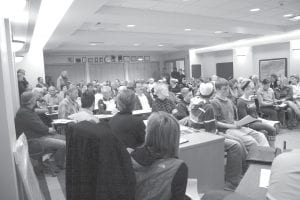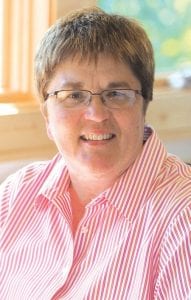Well over 100 people packed the county commissioner’s room at the courthouse in Grand Marais on Tuesday, May 10, 2011 to talk about the proposed new community center.
Commissioner and Community Center Steering Committee Chair Sue Hakes, who facilitated the meeting, explained that the committee has tried to include as many suggestions from community members as possible in coming up with an initial design. One of the purposes of this public meeting was to gather more input.
“This is a work in progress,” Hakes said. She hoped that the facility would be a collaboration of the East End, West End, Gunflint Trail, and Grand Marais, of the city, the county, and the schools, and of young, old, and everyone in between.
Committee members conducted some research by visiting other community centers in other parts of Minnesota. Most successful community centers have three elements in common, Hakes said: a pool, a fitness center with a walking track, and a gymnasium that can also be used as a multi-purposes space for large groups of people. While the committee has proposed dedicated spaces for both youth and seniors, it has planned for numerous multiuse, sharable spaces, some with beautiful views of Lake Superior.

It was standing room only in the Cook County commissioner’s room on Tuesday, May 10 when the Cook County Community Center Steering Committee presented preliminary plans for a new community center facility. Over 100 people crowded into the room, spilling out into the hallway. Thirty-three citizens asked questions or made comments on the plan.
Building the new facility will affect other amenities in the area. The committee is considering the possibility of continuing to use the current Community Center building for curling and possibly creating a warming house and changing area for hockey players who would use a new outdoor hockey rink north of the current building. The tennis courts, some which were newly refurbished last summer, would be relocated, possibly to the other side of the Cook County Schools complex. The playground would be relocated to the east side of the new facility, which would be built just east of the current Community Center.
The committee hopes to break ground this fall.
Budget
Architect Tim Meyer said they spent about six weeks simply considering a budget the county could handle. Hakes said the committee is not interested in adding taxes or taking from cash reserves to build or maintain the new facility. Cost estimates project that staffing would comprise about two-thirds of the operating budget.
The proposed building is 44,980 square feet — just under an acre — and is expected to cost $11,000,000. This would include upgrading or relocating outdoor amenities such as ball fields, tennis courts, playground, and skate park but would not include the cost of furniture, fixtures, and equipment. Consultant Wade Cole said this is a good time to build because costs are low right now.
Operating costs are one of the top concerns, with the proposed building needing about $325,000 more to operate than it would generate in revenue and program funding. “Even though it’s more – and we’re hoping to close the gap to zero – we’re getting more,” Hakes said.
The committee is looking at membership fees for use of the facility but hopes to keep some amenities free to the public, such as the walking track. They also hope to offer discounts, such as dollar night at the pool. Current budget projections show 395 memberships with fees of $25/month for young adults, $35/month for regular adults, $30/month for seniors, $55/month for families and a daily admission fee of $4.00.
Current Community Center Director Diane Booth said the committee anticipates needing approximately 10 fulltime workers (administration, front desk, maintenance, lifeguards, and program coordinators). Personnel costs would be greater if the county rather than another entity such as Community Education were the employer. Costs could be further reduced if more of the positions were part-time.
Comments and questions from the community
Community member Kelly Swearingen expressed concern over the necessity of a new community center when recreational space needs are already being met in other facilities. Why not use the 1 percent tax revenue authorized by the state for recreational infrastructure to improve the current pool and Senior Center? she asked. Grand Marais already has two fitness centers (one owned by the school, the other a private business). “The duplicity here upsets me,” she added.
Mike McEnelly wondered why a community with declining student enrollment needs more gymnasiums. School superintendent/ committee member Beth Schwarz said scheduling is a problem during the basketball season, and the elementary gym is not conducive varsity basketball games. Commissioner Hakes added that the tennis association struggles to find enough court time.
Rhonda Silence pointed out that while the Arrowhead Center for the Arts is a beautiful facility, it isn’t big enough to accommodate some of the community’s needs, such as for graduation ceremonies. Downsizing this new facility might leave the county with something no bigger than facilities that already exist. She asked how big the proposed walking track is and was told 18 laps per mile. People won’t use it then, she said.
Architect Tim Meyer said that downsizing the building to an $8,000,000 facility would still leave a $175,000 gap in funding for operation and maintenance because revenue from memberships would go down.
We need to accept the fact that we already passed the referendum, Rod Wannebo said. “If we cut [the facility] down to nothing, it’s nothing. …We have to take a few risks. We think the economy’s going to go to hell – it’s already been there.”
Kristen Anderson suggested that the county could make money by leasing some space in the new facility for a private business to set up a coffee and snack shop.
Pete Gresczyk said he thinks the county should avoid competing with private business. Brian and Marcy Olsen, owners of the Pumphouse fitness center, said they were never approached about the possibility of moving their business into the new facility. Diane Booth conceded that they should have explored this possibility earlier.
Tod Sylvester suggested demolishing the current community center, since he has been told it is deteriorating anyway, instead of relocating other amenities that are in good shape, such as the playground, the tennis courts, and the skate park. He also expressed skepticism over whether they could count on rec park guests using the new pool since it won’t be in the park like the current one is.
Why not incorporate the current building into the new building? Betsy Perry asked. Architect Tim Meyer said they considered that, but it added to the cost of building and maintaining the facility.
Businessman Hal Greenwood expressed concern over how the county could fund a new community center if the state were to exercise its authority to cap levy amounts, especially with serious financial challenges at the hospital and the school. He presented a petition from community members opposed to the new facility but apologized for not being supportive. “I don’t like to be opposing things, in fact, it’s not my style,” he said. At Commissioner Hakes’ request, he agreed to help the committee with its financial model.
Approving the referendum authorizing the 1 percent tax, said Gene Erickson, was like giving $1,000,000 to a bunch of sailors and telling them to stay sober.
Business owner Michael O’Phelan said when he voted yes on the referendum, they were assured that operating costs would not increase taxes. In fact, he said, they were told efficiencies in space, staffing, and energy use might decrease current costs.
Jim Vannett asked if the committee had come across any other communities as small as this one with $11,000,000 community centers. “Probably not,” Diane Booth said. She had pointed out earlier, however, that this county draws tourists in large numbers, which many other small communities do not.
“I think the community center is a great asset to our community,” said Rod Wannebo, although he supported keeping operating costs to a minimum.
Theresa Oberg said she would like to have a facility where her whole family could go together to do a variety of activities.
Young families “are dying for this,” Early Childhood/ Family Education Educator Lynn Sheils said. “The families are so excited for this. They see it as a way to bring the community together.”
School Nurse Allison Heeren called the proposed facility “a convening center of positive activity.”
Beth Schwarz said the committee could use recommendations on where reductions in size or amenities should be made. “We need to know what it is that needs to be cut out of there,” she said.
The goal is still no net increases in operating costs, said Commissioner Hakes. “The feedback we’re getting tonight will be taken very seriously.” See the Community Center proposal at the Cook County website: www.co.cook.mn.us.



Loading Comments